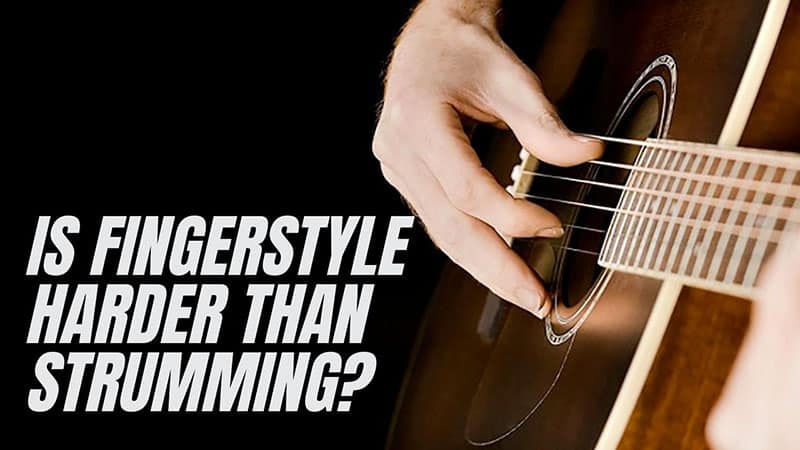For a newbie guitarist, one of the most prominent questions that determine the future of their guitar playing. And that question is, “Is fingerstyle harder than strumming?”
Fingerstyle playing is much harder than strumming in my opinion, both for learning and playing. For the fingerstyle technique, your fingers need very precise coordination to pluck individual notes and maintain agility. Whereas strumming is pretty straightforward required no such complexities.
Not necessarily one technique is better than the other just because of their difference in complexities, they simply provide different flavored music. And both techniques have their own specialty that makes them lucrative. Let’s explore a bit deeper so that you can decide for yourself which type of guitarist you want to be.
Why Fingerstyle is Harder: Fingerstyle vs Strumming
You can strum using a guitar pick as well as your hand. But for convenience, let’s consider the strumming is done by guitar picks mostly. And for fingerstyle, we are going to assume that nothing other than fingers is being used.
| Fingerstyle technique | Strumming Technique | |
| Playing technique | Using fingers for playing individual or collective or all the strings | Using a flat-pick to play all the strings at once. |
| Sound | Sounds softer, creamy, and more natural | Sounds bright, powerful, and beautifully coarse. |
| Guitar chords | Other than major or minor chords, this technique utilizes some complex chords | Complex chord shapes are rarely used for strumming |
| Type of guitar | Fingerstyle is optimal for classical or nylon-stringed guitars, as they are design | Strumming is great for steel-stringed acoustic guitars as well as electric guitars. |
| Type of music | Most popular for flamenco and classical music, also used for jazz and folksy pieces. | Mostly popular in Pop, rock, and blues, Some modern genres like alternatives, progressive rock, and others also predominantly use this. |
| Playing difficulty | One of the hardest guitar-playing techniques. | One of the most popular techniques, comparatively easier. However, the difficulty level varies depending on the type of music. |
The difference mentioned above clearly states some of the obvious difficulties that the fingerstyle technique has and the strumming technique doesn’t. let’s dive a bit deeper.
Maintaining Both Finger Dexterity
If you look carefully, for the fingerstyle technique, both of your hands need an equal amount of finger dexterity and coordination. Moreover, you won’t be able to keep your eyes on both of your hands. Therefore, one hand needs to develop fully automated muscle memory; in most cases, it is the dominant hand or picking hand.
Your Fingers Need Strengthening
For fingerstyle playing, fingers from both your hands need strengthening. Initially, your fingers will blister from the corrosive actions from the nylon string or still strings. Although nylon strings make it a bit easier, they would still hurt your fingers initially until they are strengthened and well-adjusted.
Playing Polyphonic Rhythms
Not to through you off with heavy jargon, but this is important and you should know about polyphonic rhythms as a guitarist. Basically, Polyphonic Rhythm refers to the rhythm or multiple notes played in different beats.
Common people are usually familiar with the downbeats of the rhythm (on the count: one, and, two, three and four … ‘one’, ‘two’, ‘three’, ‘four’ are downbeats). But for polyphonic rhythms, you’d need to play notes on upbeats as well as downbeats, and the beats in the middle.
Timing
Polyphonic rhythm already deals with the timing, but I still have to emphasize that, your picking fingers would need to play different notes on different timing. Hence, they need to develop such muscle memories. And your fret hand would need to switch the root notes and melodies within the nick-of-time which is very, very tricky!
Why Strumming is Easier
First of all, strumming is pretty simplified, comprised of upstrokes, downstrokes, etc. And these strokes are often aligned with the beats: Downstrokes for downbeats and upstrokes for upbeats, sometimes swapping them and sometimes add an extra stroke in-between. Simple, isn’t it?
Moreover, if you can use a guitar pick. Although it is a bit tricky to hold a guitar pick and getting used to it, still that is much comfortable than your fingers hurting.
Last but not the least, rhythms that are fairly straightforward are easy to be picked up only by hearing the music. That’s how your music sense on strumming and relevant rhythm develops quicker.
Exceptions
The differences we’ve mentioned above are fairly generic because there are countless exceptions.
Fingerstyle guitar players mostly play classical guitars or nylon string guitars. A classical guitar is dedicatedly built for the convenience of fingerstyle playing whereas an electric guitar is not. Although, there is lesser space in between electric guitar strings, making it difficult to play fingerstyle, that didn’t stop electric guitar players like Mark Knofler.
If we talk about difficulty, not all strumming technique is easier than fingerstyle. A simple song with a very basic rhythm doesn’t speak for all the strumming patterns. Check out some modern-day artists like Tim Henson from Polyphia or Manuel Gardner Fernandez from Unprocessed for some kick-ass strumming.
Moreover, although fingerstyle is predominantly in the domain of classical music or flamenco, the possibilities to use fingerstyle are limitless. So, no matter what type of guitar you have, you can use any technique of your preference.
However, using a flat guitar pick on a classical guitar is musical blasphemy! Gotta remember that!
Fingerpicking and Fingerstyle
Aren’t these techniques the same? Well, not really, although they are used quite interchangeably. Of course, they are very much related, that’s why using these terms synonymously won’t be the end of the world.
Since I want you to become a discerning musician or guitarist, I should clarify the subtle differences between fingerpicking and fingerstyle.
Fingerpicking is mainly the technique of playing the guitar strings with your fingertips or long fingernails. On the other hand, fingerstyle is a set of techniques like fingerpicking, slapping, tapping, and so on – making it a unique style.
Similarly, strumming is also a set of techniques including palm muting, Up-strokes, Down-strokes, pinch-harmonic, etc. And we are comparing the difficulty level among two sets of techniques for guitar playing: fingerstyle and Strumming.
Should You Learn Fingerstyle Guitar Playing
When it comes to guitar playing, most of the guitar players have the basic skill of playing both the styles: fingerstyle and strumming, advanced guitarists usually master both. Even a rhythm guitarist needs to play some simple fingerstyle interludes.
You’d have to learn fingerpicking eventually because it is sort of a must-have skill for an aspiring guitarist. For other advanced fingerstyle techniques that are used mostly in flamenco-type guitar playing, you can master it later if you wish to walk to that path.
Starting With Fingerstyle: Good Idea or Bad?
Many suggest not to try fingerstyle at the beginning of your guitar playing journey because fingerstyle is really difficult and it might demotivate you. Although there is some truth to it, it won’t hurt to have a simple fingerstyle technique up your sleeves. So, to avoid demotivation, start with strumming, then go for some basic fingerstyle patterns.
So, depending on the music you are interested in, eventually you will end up preferring one of the guitar-playing styles more than the other. Whether you wish to go full strumming or full fingerstyle, you’d be able to decide once you’ve got a hold on to your guitar skills.
Tips to Learn Fingerstyle
Like always, start with easier fingerstyle pieces with a basic pattern of fingerstyle techniques. I know, that the classical player who plays super difficult songs on their classical guitar seems way too cool and you want to play like them too. But one step at a time my friend! With consistency, you’ll definitely get there.
How to Train your Finger
Fingerstyle techniques demand you to play individual notes using fingertips, therefore sometimes it might help to have long fingernails. A root note, also referred to as a bass note is often played with your thumb while the melody is being played with your index, middle, and ring fingers (the pinky is redundant in most cases), in different combinations.
So, you’d have to train each finger, especially your thumb separately. Then train them with different combinations such as “thumb + index finger”, “thumb + index + middle finger” or “middle + ring finger” – you get the idea. There are numerous exercises to practice such combinations.
What fingerstyle Chords Should You Start with?
The good news is, you can play both strumming and fingerstyle over the same chord progression As a rule of thumb, you start with basic chords whether playing using strumming techniques, fingerstyle, or finger picking. Chord shapes like major or minor chords should suffice for now once you develop your finger’s muscle memory.
Music to Practice with
If you are a fan of classical music, you might find numerous classical pieces that are quite simple and easy. Plus, if you have a classical guitar, then it would be pure bliss.
Not a fan of classical music? No problem! There are a bunch of modern pieces that are
How Many Hours of Practice Required?
Decent hours of practice are required to master advanced fingerstyle patterns, especially Fingerstyle with melody. Any guitar player would agree that the practice time for such a difficult style is significantly more than your average guitar playing.
I regret to tell you that, most of the noob acoustic guitarists use the same old boring strumming pattern which appears like a piece of cake, which it actually is.
Hybrid Picking
As for me, I am one of the flat pickers but sometimes I use hybrid picking. If you haven’t heard about hybrid picking already, it is one of the picking techniques that use both the flat-pick and the finger(s), mostly the middle finger.
I am a righty, so my Right-hand techniques needed some work done to get used to hybrid picking. It is not as difficult as an advanced fingerstyle technique, but depending on the type of music, you might have to break a sweat sometimes.
FAQs
Can You Strum with Your Thumb?
Of course, you can strum with your thumb, in fact, it is one of the most common fingerpicking or I should say ‘Finger strumming’ techniques.
The thing to notice is that strumming with your thumb will produce a fuller, bass-rich warm tone. Whereas, strumming with the back of your fingers (I do that sometimes) would give you a bright tone, almost like a pick.
So, you have the full freedom to make the sound you like without even using a guitar pick.
Is Fingerstyle the Hardest?
It is all relevant. For me, yes, it is probably one of the hardest techniques I’ve ever come across. But it’s not unachievable.
Interestingly, I am a heavy metal guitarist and I can play guitar riffs from Lamb of God, Slayer, or Megadeth with ease. And such guitar riffs might be scary to a lot of classical fingerstyle guitarists.
So, there is no such thing as “the hardest”, it really depends on your preference and the amount of dedication you are willing to put into it.
Should I use Artificial Fingers for Fingerstyle Playing?
This is one of the options you can adopt if you are truly serious about fingerstyle and you want to master it to the fullest. But if you are like me, learning fingerstyle as a side skill, then I would not recommend it that much.
Final Words
Fingerstyle or strumming, one is comparatively harder than another, but both are really cool!! So, don’t feel like you have to choose the harder one to prove yourself as the better guitarist. Learn the basics of both techniques, and go with the one that you love the most. And keep on rocking!!!



